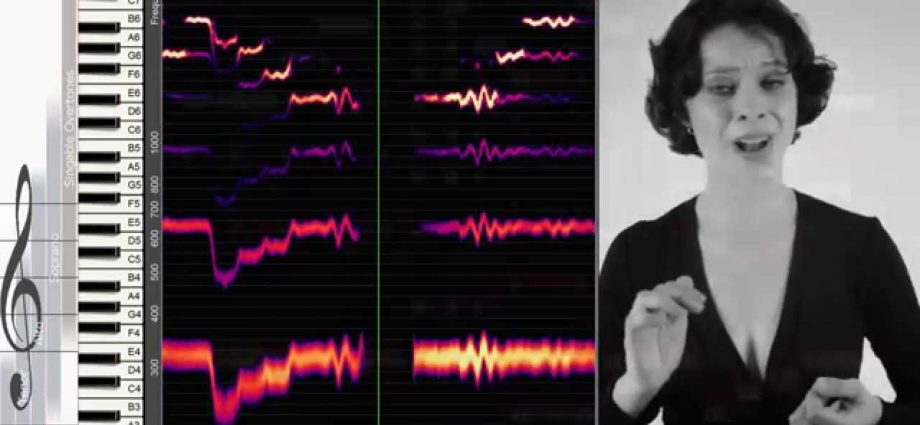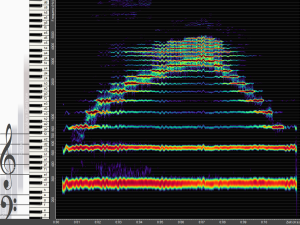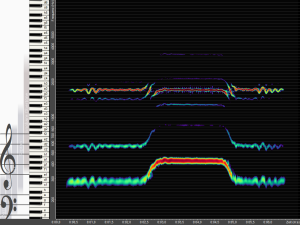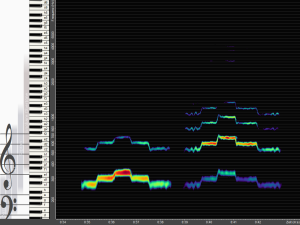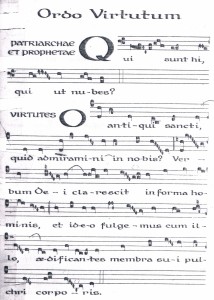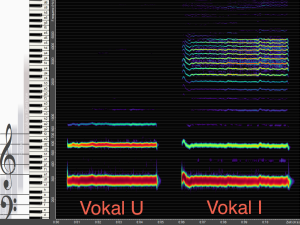By Anna-Maria Hefele, Overtone Singer, Vocal Artiste and Singer
Translated into English by Irene Auerbach, England
“Overtone singing is a vocal technique which filters out of the overtone spectrum of the voice individual partials in such a way that they are perceived as separate tones, creating the aural impression of part-singing”[1].
In 2005 I discovered overtone singing [overtones and harmonics are synonyms; as in discussions of overtone singing as practised particularly in ancient Mongolian folk music, the term “overtone” is usually employed, this word will dominate in the following – translator] through a radio broadcast, and the fascination for this unusual vocal technique has not left me. Ever since I have occupied myself intensively with overtone singing, primarily from the musical point of view. Also, I soon began employing this technique, and for quite some time I was a member of the Munich Overtone Choir. A classical vocal training course within my course of study of Elementary Pedagogy of Music and Dance at the Carl Orff Institute, Mozarteum Salzburg, also enabled my overtone singing technique to improve further in relation of smoothness of sound and tone quality even when employing overtone technique, and also aided the flexibility which allows me to alternate between classical and overtone techniques. Through singing overtones one learns a very precise, conscious ability to steer vocal formants, resulting in a really finely honed perception for vocal and other sound colours. Overtone singing exercises the breathing apparatus as well as a tight closure of the vocal chords to a high degree, something that helped my classical singing voice (soprano) achieve a great and also very clear height, with good intonation.
In 2014 I published a video that became very popular within a very short time, “Polyphonic Overtone Singing – Anna-Maria Hefele” http://youtu.be/vC9Qh709gas about the possibilities of overtone singing in parts, as there is still little awareness among musicians, composers, interpreters and conductors as to the manifold musical and artistic possibilities of using overtone singing. In the following video, “Polyphonic overtone singing – explained visually http://youtu.be/UHTF1-IhuC0 the examples which are shown can be followed even more easily with the aid of the real-time spectrogram of the overtone analyzer www.sygyt.com. Here now come examples of the musical and technical possibilities of overtone singing, as also explained in the video, displayed through screenshots of the spectogram:
A – The fundamental remains stable, the overtone changes. This is the most frequently used and most easily learnable variant of overtone singing.
B – The overtone remains stable and the fundamental is changed.
C – The fundamental moves in parallel with the overtone. The movement can take the form of a glissando or of exact intervallic steps.
D – Fundamental and overtone move in opposite directions.
By combining options A-D it is possible to establish a complex vocal technique in more than one part.
Overtone singing can easily be notated, using two staves. The fundamentals’ part will be found in the lower stave. The overtones are notated in the upper stave, often an octave lower than the actual sound. The numbers between the staves always describe the relationship between fundamental and overtone, namely the number position of the notated harmonic in relation to the respective fundamental, independent of the pitch of the latter.
Graph: overtone series starting from d. The fundamental counts as first harmonic. Harmonics are always multiples, in whole figures, of the fundamental, and thus some harmonics possess more or less noticeable deviations from the tempered tuning system. For the sake of simplicity, I will not go into this any further here.
Overtone melodies are commonly sung in the area between the fourth and the sixteenth harmonic, as higher and lower harmonics are hard to filter and also, their musical use declines due to the intervallic distances between the individual overtones, which become very large or very small. The higher the sung fundamental, the fewer harmonics above it are still singable; therefore, for a female voice, due to its pitch, it is hardly possible to reach the sixteenth harmonic. Therefore I started very early with part-singing in overtones, in order nevertheless to be able to create the melodies which I envisaged.
Overtone singing in parts is overtone singing with deliberately changing fundamentals. For any one overtone in the desired melody, there are often several possible fundamentals. This can then be selected according to one’s own vocal range and the physical properties of the row of fundamentals. When making these selections, we must heed any possible harmonic or contrapuntal functions of the fundamental.
Illustration: the beginning of “Longing for Spring”, following W A Mozart’s folksong arrangement.
An artistic attempt at applying overtone singing in parts is my somewhat free arrangement of the chorale “O Antiqui Sancti” by Hildegard von Bingen (1098-1179) from the liturgical drama “Ordo Virtutum” (The Game of the Powers). This can be called up under:
- URL1: www.soundcloud.com/anna-mariahefele
URL2: www.anna-maria-hefele.com - URL3: www.supersonus.eu
- Video1: http://youtu.be/s4BJ3wng6Mk
- Video2: http://youtu.be/ysSLfwEk5l4
- Tel.: +49 176 65221264 (D), +43 680 2346759 (Ö)
“O ye saints of the old testament, why are you so surprised by us? The word of God shines, is heard, becomes bright and clear in human form, and thus we sparkle, shine and lighten up in him by laying places of fire, by building and setting on fire the limbs of his beautiful, brightly shining body”.
Of course Gregorian chant is not really intended for interpretation in several parts; nevertheless I found the use of harmonics in these sounds and melodies highly fascinating. In my arrangement the melody of the piece changes between the line of the overtones and that of the fundamentals, apportioning the function of accompaniment to whichever part has not got the tune.
A further, innovative project is “Supersonus – the European Resonance Ensemble” (www.supersonus.eu). Using a combination of overtones (overtone singing, Jews harp) and instruments rich in harmonics (nyckelharpa, kannel [plucked, unstopped zither as in use around the eastern Baltic Sea – translator] and harpsichord) we are seeking a sound that finds its roots in the archaic-folkloristic as well as in old musical styles as the Baroque.
The Technique of Overtone Singing
A (vocal) sound will always consist of a fundamental and the harmonics contained in it. The vocal colour is determined by the mixture of the harmonics, i e the distribution of volume over the spectrum of the harmonics. Vowels only differ from each other by the differing volume of the overtones within the vocal sounds. This physical fact is exploited by overtone singers: they learn to distinguish vowels so clearly that through fine differentiation in the approach to the vowel colours, individual overtones are picked out of the sound and thus can be heard as additional notes.
In western vocal technique, we primarily employ the vowel transition between u and i. This can be achieved by the vowel transitions in the words “oui” and “you” (this can be heard under http://youtu.be/HP0iotICL7k, starting at minute 0.45). Of course open vowels like a and ä also have harmonics which can be made audible, but in these, other overtones will always join in comparatively strongly.
illustration: The vowel transition “oui – you”, sung on an unchanging fundamental.
The bottom line is the fundamental, the second unbroken line is the 2nd harmonic, which can hardly be filtered out. The resulting triangle are the filtered harmonics.
The vocal technique is fairly simple, can be learnt in a short time and is thus well suited for use in a choir. It fits in well in the classical, smooth use of the voice. However, if using the vowel technique, you cannot sing such loud overtones as you can when employing tongue technique, the learning of which is a bit more complex. For overtone singing in parts we tend to need the loud, whistling overtones which will only come to be when the tongue technique is employed. More information about the vocal techniques can be found here: http://www.oberton.org/obertongesang/was-ist-obertongesang/.
The Use of Harmonics for Choral Work
By occupying ourselves with overtones we learn to differentiate more clearly between the colours of the vowels as well as to set up the best possible resonance in our bodies.
If we guide the overtones via the vowels, we must think in far finer gradations in vowel colours than we usually do when singing or speaking.
The brighter the vowel and the higher the harmonic, the smaller the differences in the settings required for the vowel colour will become, as the overtones cluster ever more closely the higher we get. Thus, by listening out for the dominant overtone in a vowel, we aquire a much more sensitive “grid” for the perception of vowel colours.
Through this learning process the blend among the choral singers in respect of intonation and tone colour will improve, and thus the choir’s overall intonation.
Also, the sinking of pitch of the choir will be prevented when overtones are carried along in the vowels, and the vowels are sufficiently brightly shaded.
Sundberg: “ … problems of intonation within a chord on the vowel “u” might disappear if in the first rehearsals this vowel is temporarily replaced by “a” or another vowel with stronger harmonics.”[2]
Generally speaking, the sound perception of any individual will be expanded by occupation with the harmonics of vowels, even if no specific overtone technique is learnt. With time, quite automatically, you begin to hear the overtones contained in every sound or noise (and also in the sound of a choir).
It is very useful for intonation to work out overtones common to the parts within a chord and to adjust the vowel colours accordingly. Thus e g the male voices may meet up on the same harmonic, though they are singing different fundamentals. In order to achieve this, we must adjust the vowel shadings, i e the different sections of the choir sing somewhat different vowel colours. The lower the fundamentals, the more harmonics there are to choose from, and the smaller the deviation of the vowel that needs to be made.
A musical example for choral work with overtones might be the colouring of vowels in a sung text in such a way that one overtone within the sound is louder than others. According to pitch and vowel there will sometimes be several overtones to choose from, so that the vowel remains recognizable, particularly in the male voices.
Here – for example in the final chord of a piece – you can decide whether, within the vowels, you would like octaves and fifths strengthened in the overtones. This will result in a very smooth and rounded tone. Or a seventh or eleventh harmonic may be chosen as the main resonator: that will result in a delicate harmonic difference.
Thus, by the use of precisely aimed-at harmonics in the vowels, the intonation as well as the effect of chords in choral music can be supported.
Very detailed information and related exercises are to be found on the website of Wolfgang Saus: http://www.oberton.org/chorphonetik/. At the end of the article there is a link for a free download with music examples, available in German and English.
An overview of all notated compositions for overtone choir and solo overtone singing can be found here: http://www.oberton.org/obertongesang/werke/.
[1] Most of the background information concerning overtone singing is based on Saus, Wolfgang: Oberton Singen, 4th edtion (2011), Battweiler: Traumzeit Publishing, 2004 – ISBN 3933825369
[2] see: Sundberg, The Science of the Singing Voice, 191.

